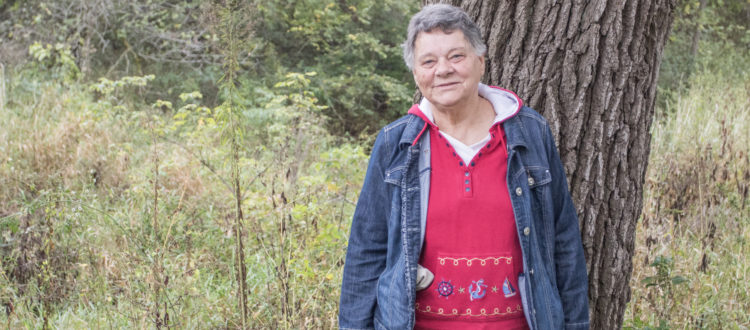Cultivating a Thriving, Walkable Woodland that Will Endure for Generations
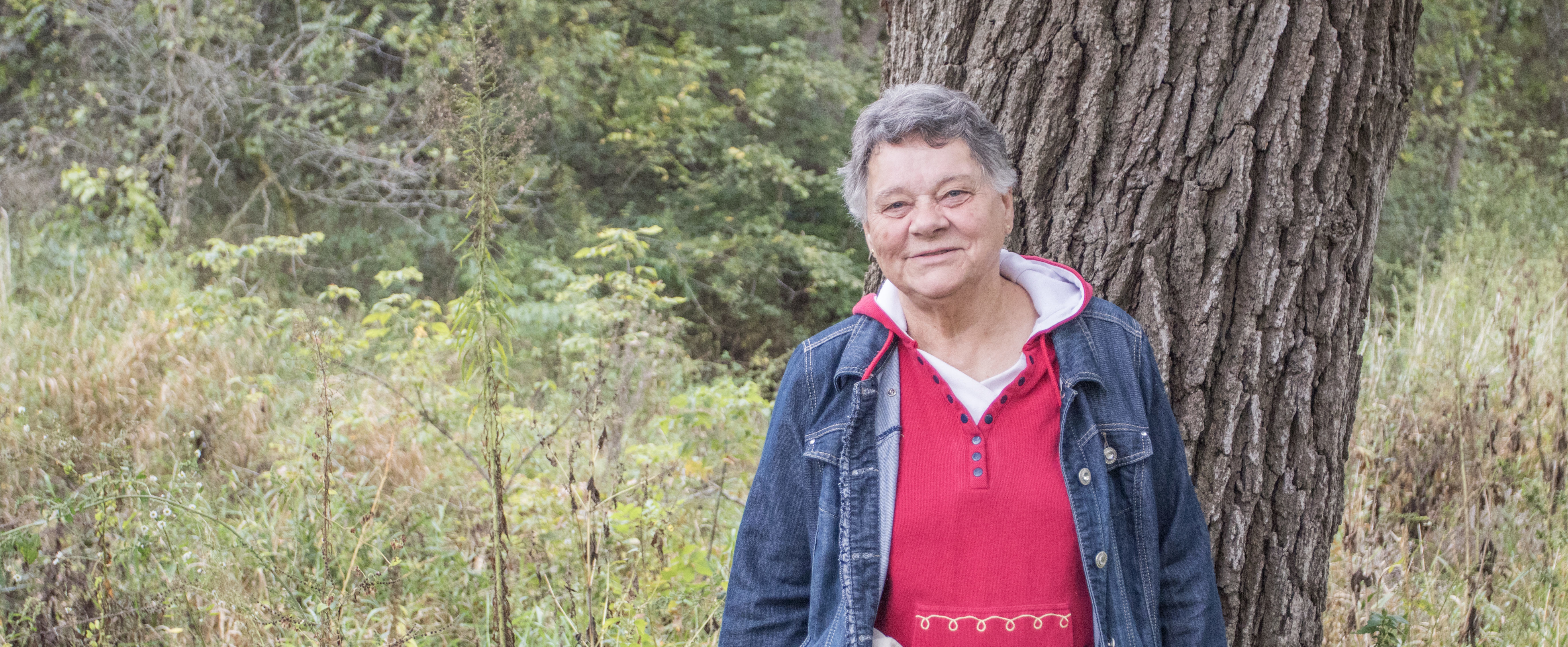
Ione Cleverley is managing her Jasper County forest and crop fields to promote wildlife habitat, marketable timber, and clean water.
In the fall of 2016, Ione Cleverley had been reflecting on her 50 years of land ownership and knew it was time to take action. Although her woodland management practices remained the same, the ecology of the woodland was changing–and not for the better.
“The timber ground was in sad shape–the multiflora roses had increased tremendously, you couldn’t really walk through it because of the brush overgrowth,” Ione explained. “I wanted to tackle that problem and improve it as much as we could. I had to clear it first because of the fact that you couldn’t get in there.” With the help of her two brothers, one with a small caterpillar and the other with a skid steer, she was able to clear the brush enough to get into the woodland and chop up the invasive overgrowth.
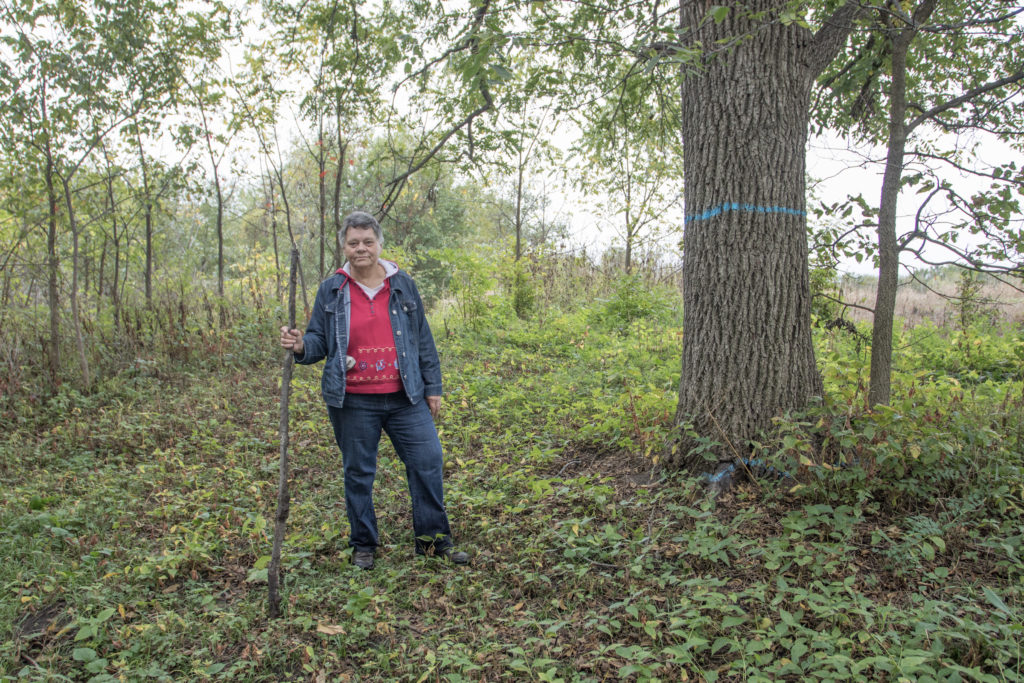
This black walnut tree is marked in blue for harvest as part of a timber sale, conducted collaboratively with several of Ione’s neighbors.
Then, when some of her neighbors were getting together to conduct a timber sale in the fall of 2016, Luke Gran, forester at Prudenterra, met with her to see if she wanted to participate. She did. But while they were walking through her woodland, they ended up talking about other topics as well, such as how to manage the multiflora rose and other invasive species, while regenerating of desirable species like black walnut, shagbark hickory, and various kinds of oaks.
“He suggested a different approach than what I was doing that would be better for clearing the timber. When you get a caterpillar in there, some of the smaller trees would get bumped and scraped and it does some damage. When you push the multiflora rose down, it cuts them down but doesn’t kill them,” described Ione. As an alternative, Luke recommended that Ione use a combination of spot spraying them within two weeks of bloom, and prescribed woodland burning to effectively kill and discourage the invasive species without damaging surrounding native vegetation. Then, he suggested that where they had previously cleared out the woodland, she consider planting some trees of high value for both wildlife and timber.
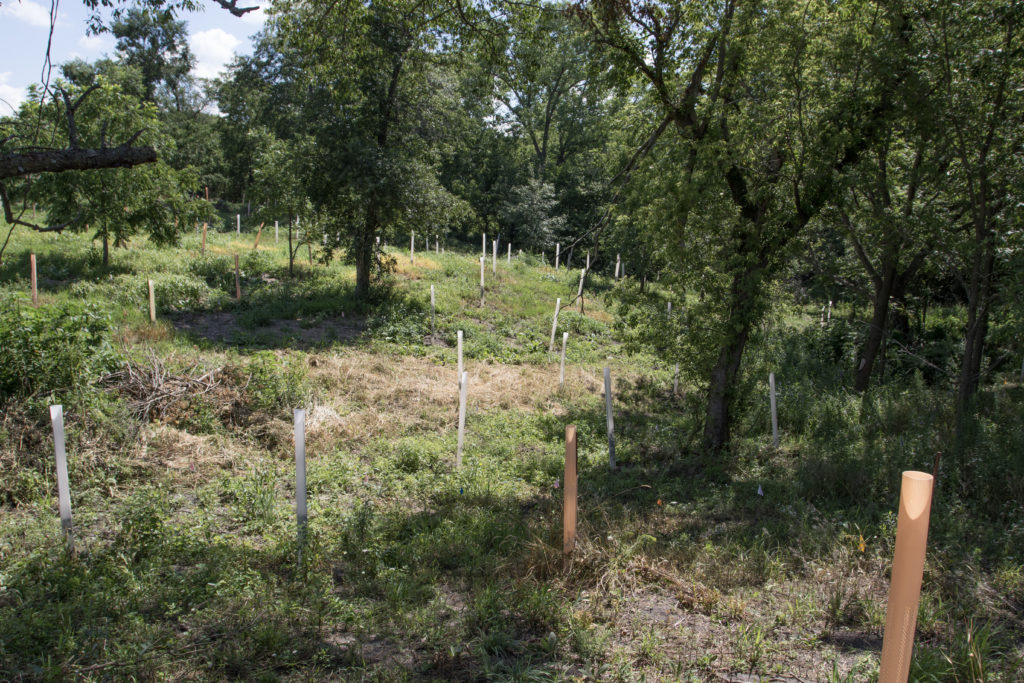
Half of the seedlings that were planted as part of the spring reforestation project are protected in tree shelters to prevent deer browse.
In April of 2017, Ione decided to commence reforestation by planting nearly an acre with bare root tree seedlings. On the well drained ridge of the hill, she worked with Prudenterra to plant white oak, bur oak, and shagbark hickory on the south-facing slopes, and kentucky coffee tree, hackberry, black cherry, and black maple on those that were east-facing. More water tolerant species such as black walnut, bur oak, and swamp white oak were planted in the wet draws and bottomland.
Nearby, on a small area adjacent to a crop field is a second site that will be reforested this fall. A different approach to reforestation will be used, however, because of this site’s high edge-to-area ratio and consequent high susceptibility to deer browse. Direct seeding of thousands of nuts per acre will put the odds in the favor of the trees to successfully regenerate. In October 2017, Prudenterra will direct seed four bushels per acre of diverse oaks (red, black, bur, white), shagbark hickories, as well as ten bushels (480 lbs.) per acre of black walnuts.
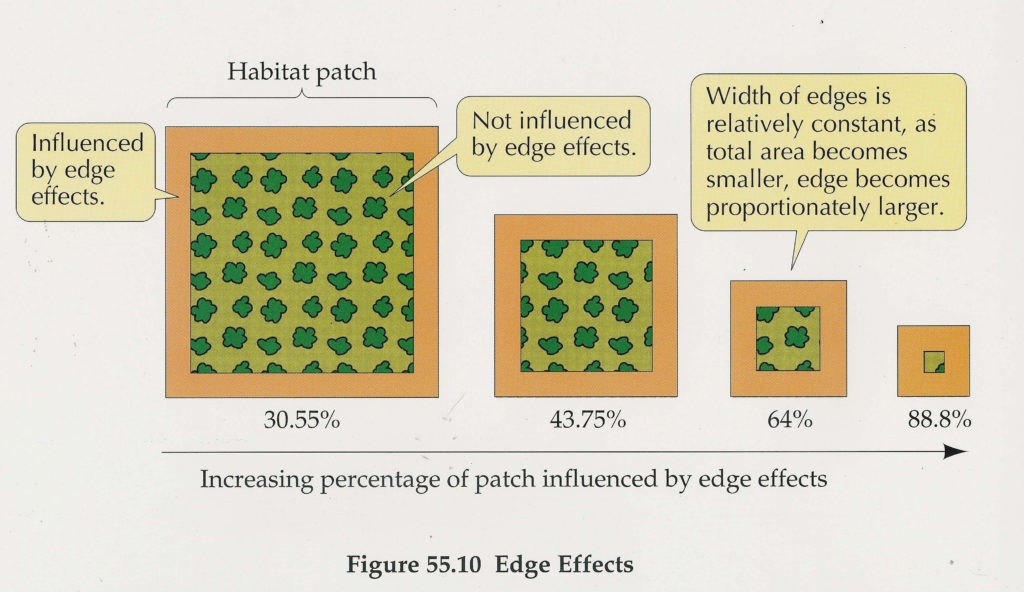
Edge-to-Area Ratio. Graphic courtesy of The University of Texas.
Ione has also been managing other areas of her woods, working with Prudenterra to remove larger non-native, invasive, or diseased vegetation that requires chainsaws to cut or girdle them. “I consider the timber land an investment for future generations–my children and grandchildren,” noted Ione. “It’s an investment in improving air quality and water quality. I would like to see more wildlife in the area, and more habitat for bees, butterflies, and other pollinators.”
With so many complex factors–different areas of her woodlands with high value timber species at risk from invasive species, erosion, and poor regeneration of desirable species–Ione wanted to make sure she was wisely prioritizing her management. “I believe that we are stewards of the land and it is our responsibility as owners to improve and care for our land the best way we can and the more knowledge we have the better. The more knowledge you have on how to improve it increases your success in doing this.” She decided that this winter, before taking any further management actions, she will pursue a Forest Management Plan to have more data to detail tree species, condition, and timber value, as well as whether forest thinning would be profitable in each stand.
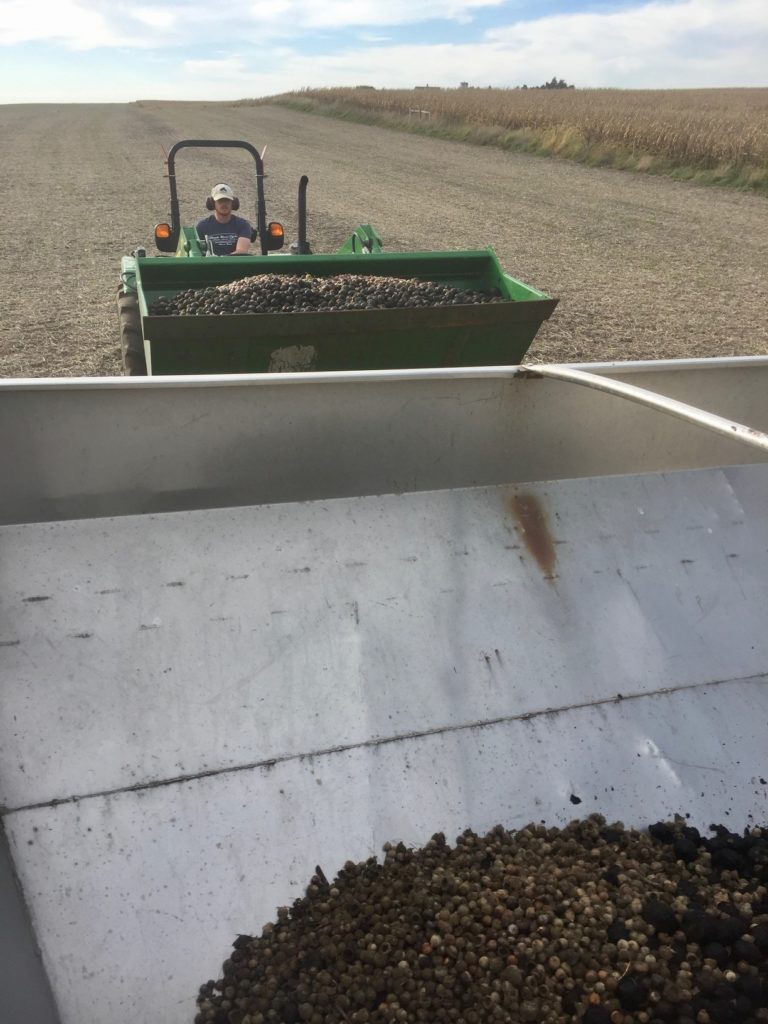
Oak acorns, hickory nuts, and black walnuts are loaded into the seeder (provided by Heartland Co-op) for a direct seeding reforestation.
At the same time Ione was gaining knowledge and taking action to improve habitat in the woodland, she was using the same approach for her crop fields. After the harvest this fall, she will be taking some cropland out of corn and soybeans to plant a 30 feet wide buffer of native prairie around her woods. Ione is also working with her tenant to transition the cropping system to no-till with cover crops. Additionally, she is researching options to install Prairie STRIPS or field terraces in her largest field.
Ione said, “What peaked my interest in these practices was observing the fields of some of the farmers who are trying it, after they plant the cover crop how much better it looks. I can see how it would help with conservation and water run-off—some of the gulleys and washouts disappear when you start no-tilling.”
Wolf Creek runs through the bottom of the hill in her woodland, and Ione wants to ensure that water coming out of her crop fields is as clean as possible before it flows into the creek. “My hope for the future”, explained Ione, “is to improve the land with these practices, but also to improve water quality, air quality, to deplete erosion–so much of the ground washing away. I would like to leave it in a better condition than when I found it.”
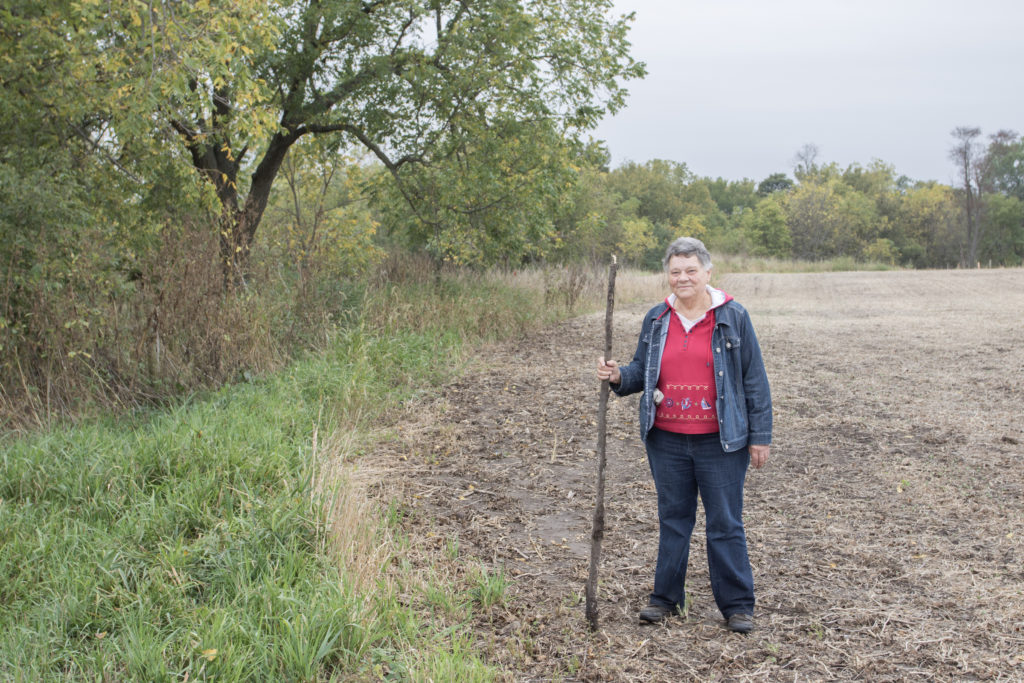
A 30 feet wide prairie buffer for pollinator habitat and water filtration will soon be planted here, where the crop field borders the woodland.
Beyond growing cover crops, which reduce nitrogen and phosphorus pollution by around 30%, Ione’s buffer strip will remove nitrogen (91%) and phosphorus (58%) from water that flows through the buffer’s active root zone. In the heavy rains of recent years, the edge of the forest has been susceptible to erosion from field run-off. The stiff stems and dense roots of prairie plants will intercept and slow the flow of water, and allow more of it to soak into the soil it before it enters the woodland.
With modern threats to woodlands like the invasive multiflora rose, Ione’s work is far from over, but 50 years of forest and farm stewardship has given her a long term perspective. “I feel like I’m just a caretaker for the land–it goes on from generation to generation. Hopefully I can pass some of it and that ethic on to my children and grandchildren.” Her grandchildren, who enjoy exploring the woodland with her when they come to visit, will have the opportunity to see the oak, hickory, maple, and walnut seedlings reach full maturity. And with Ione’s land ethic at work, there will also be a rich diversity of plants and wildlife to greet them for many years to come.
See Reforestation in Action–Watch a short video of the direct seeding at Ione’s farm here.
Ione Cleverley was recently featured in National Geographic—The Simple River-Cleaning Tactics that Big Farms Ignore.

